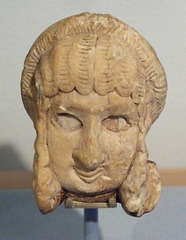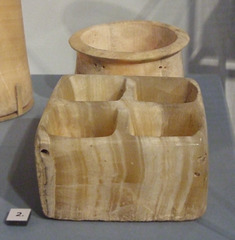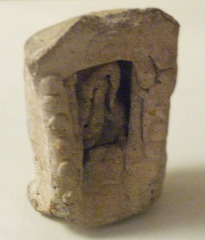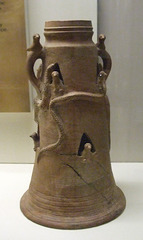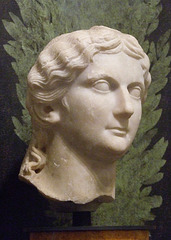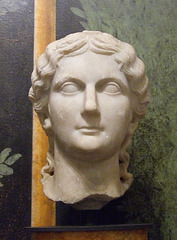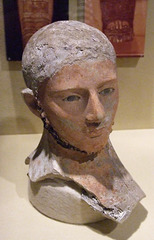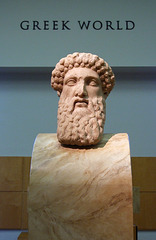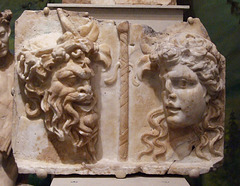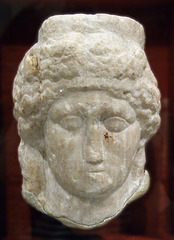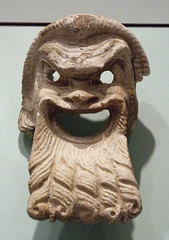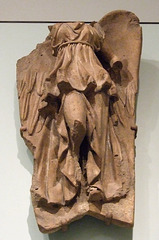LaurieAnnie's photos
Sumerian Female Statue Fragment in the University…
| |
|
Statue Fragment (female)
Alabaster
2600-2350 BCE
Khafaje, Iraq
# 38-10-51
Text from the U. Penn. Museum label.
Sumerian Alabaster Cosmetic Box in the University…
| |
|
Cosmetic Box
Alabaster
2550-2450 BCE
Ur, Iraq (PG1100)
# 30-12-697
Text from the U. Penn. Museum label.
Model Shrine in the University of Pennsylvania Mus…
| |
|
Model Shrine
Ceramic
Amathus, Cyprus
ca. 600 BC
# MS 156
Model shrines such as this one are associated with the Phoenicians and their expansion westward into the Mediterranean. Note the typical Phoenician stylistic features like the crescent moon and sun-disk above the doorway and the proto-Aeolic column capitals.
Text from the U. Penn Museum label.
Offering Stand from Beth Shean in the University o…
| |
|
Offering Stand
Ceramic
Beth Shean, stratum V, south temple
Iron IB, 1150-1000 BCE
# 29-103-830
This offering stand is decorated with birds and snakes. These animals commonly appear on ritual objects throughout the eastern Mediterranean, though their symbolic significance remains unknown.
Text from the U. Penn. Museum label.
Marble Portrait of Agrippina the Elder in the Univ…
| |
|
Marble Portrait of Agrippina the Elder
Probably from near Troy
ca. AD 38-54
# MS 213
Agrippina the Elder (circa 14 BC- AD 33) was the daughter of Agrippa, Augustus's wealthy, lifelong friend and supporter, and Julia, his daughter. She married Germanicus, great-nephew of Augustus, and bore nine of his children. One of these was the future emperor, Caligula. When her husband died suddenly, perhaps of poisoning, Agrippina was banished from Rome and died of starvation in exile.
Text from the U. Penn. Museum label.
Marble Portrait of Agrippina the Elder in the Univ…
| |
|
Marble Portrait of Agrippina the Elder
Probably from near Troy
ca. AD 38-54
# MS 213
Agrippina the Elder (circa 14 BC- AD 33) was the daughter of Agrippa, Augustus's wealthy, lifelong friend and supporter, and Julia, his daughter. She married Germanicus, great-nephew of Augustus, and bore nine of his children. One of these was the future emperor, Caligula. When her husband died suddenly, perhaps of poisoning, Agrippina was banished from Rome and died of starvation in exile.
Text from the U. Penn. Museum label.
Roman Portrait Head in the University of Pennsylva…
| |
|
Etruscan Terracotta Antefix in the University of P…
| |
|
Terracotta antefixes
Corneto (Tarquinia)
Late 6th- early 5th century BC
# MS 1821, MS 1828
These two antefixes are from a deposit at Corneto, the countryside of ancient Tarquinii. One, with finely painted surface, shows the popular satyr head. The other shows the bearded, bullish river god Acheloos.
Text from the U. Penn. Museum label.
Bust of a Man in the University of Pennsylvania Mu…
| |
|
Bust of a Man
Plaster
Height 0.66 m
El Kharga (in Upper Egypt)
Roman Period, 2nd century AD
# E 886 a,b
This bust reflects the injection of several eastern Mediterranean influences on an otherwise traditional Egyptian theme. In contrast with the impersonal cartonnage mask placed on mummies from the Middle Kingdom onwards, portraiture of the deceased was now realistic. The general style is Hellenistic in nature, but the hairstyle and the beard match the prevalent fashions of the court in Rome.
The earliest types of this bust consisted of a hollow headpiece which was actually fitted over the skull. However later examples, like this one, were raised at an angle to the body to give the impression that the head was resting on a pillow.
Text from the U. Penn. Museum label.
Marble Grave Relief in the University of Pennsylva…
| |
|
Marble Grave Relief
Athens
ca. AD 150
# 63-6-1
The deceased lady is shown in full frontal view. She wears a low polos headdress. It is likely that she has been intiated into the rites of Demeter / Ceres whose cult promised its followers a life after death. Her pose and dress are based on a familiar Greek prototype known as the the "small Herculaneum woman." The originally inscribed pediment and much of the frame are now missing.
Text from the U. Penn. Museum label.
Herm Head in the University of Pennsylvania Museum…
| |
|
Herm Head
Probable creation of the 1st century AD after a 5th century BC work
# 30-51-1
Herms were square pillars surmounted by the head of Hermes (or, later, other divinities) and adorned on the front of the shaft with male genitalia. As the god Hermes was the patron of travelers and commerce, herms were set up as dedications to him at halfway markers between the city and the rural territories of Attica, at the city gates, and at the entrances to important public places. The tradition of herms in Attica goes back to the 6th century BC and continues into the Roman period. By the Roman period, herms were more often used for decorative rather than cultic purposes and bore little relationship to Hermes. This herm may have been double-headed with the two heads back to back as shown in the example in the photograph below.
Text from the U. Penn. Museum label.
Cult Statue Head, Probably of Diana from Nemi in t…
| |
|
Cult Statue Head, Probably of Diana
Late 2nd century BC
# MS 3483
The idealized, conservative style and the large scale suggest this head was part of a cult statue from one of Nemi's major temples. It was originally adorned with a diadem, probably of bronze.
Text from the U. Penn. Museum label.
Marble Mask of a Water Deity in the University of…
| |
|
Marble Mask of a Water Deity
Teanum Sidicinum, northern Campania
Second half of 1st-2nd century AD
# MS 4917
This mask of a bearded, hoary old man may personify either Oceanus or a river, like Father Tiber. It was found in a Roman public bath, where it was used for a fountain waterspout.
Text from the U. Penn. Museum label.
Herm of Dionysos/ Bacchus in the University of Pen…
| |
|
Herm of Dionysos/ Bacchus
1st century BC
# MS 3475
A herm was a pillar used as a boundary or entrance marker, as in a stadium. In the Roman period herms could be mounted with portrait heads. In this case the herm represents an idealized Dionysos / Bacchus with a ribbon in his hair.
Text from the U. Penn Museum label.
Plaque with Masks of a Satyr and Dionysos in the U…
| |
|
Plaque with Masks of a Satyr and Dionysos
1st century AD
# MS 3459
This is one of four marble plaques from Nemi with theater-like masks. The mask on the right represents a youthful, effeminate Dionysos.
Text from the U. Penn. Museum label.
Marble Head of Cybele(?) in the University of Penn…
| |
|
Marble Head of Cybele (?)
Roman Imperial period
# L-123-24
This head is a poorly modeled provincial work with flattened features and staring eyes. The abundant hair flowing to either side of the forehead and face are characteristic of Magna Mater's Asia Minor images. While the crown has been deliberately trimmed down, the back appears to have been attached once to a votive relief.
Text from the U. Penn. Museum label.
Comic Theatrical Mask from Minturnae in the Univer…
| |
|
Comic Theatrical Mask from Minturnae
From vaults under Temple L
Late 1st century BC- early 1st century AD
# 32-36-62
This marble mask is modelled after the stage masks made of lighter material worn by actual actors. Marble or bronze masks like this one often decorated the entrances of theaters. They also graced the interiors and formal gardens of Roman houses.
Text from the U. Penn. Museum label.
and
Minturnae Excavations
The Museum excavated at Minturnae between 1931 and 1933, under the field direction of Jotham Johnson. Johnson cleared parts of Minturnae's walls and a significant part of its center, including the Republican forum with its three-sided portico and Capitolium, the Imperial forum, the Augustan theater, and five temples. As part of a division of finds the Museum received an important selection of marble sculptures, terracotta architectural decoration, pottery, and lamps.
The Museum was not the first to excavate at Colonia Minturnae. The site was initially explored by Domenico Venuri in 1787 and again by a Napoleonic-era Austrian general named Laval Nugent von Westmeath, who removed his finds to Zagreb. The Italian authorities carried out excavations in 1940 and from 1955 to the present. They have also undertaken the restoration of a number of monuments. Minturnae's finds are today found not only here in Philadelphia, but in Zagreb, the Naples Museum, and in the museum at the site.
Text from the U. Penn. Museum plaque.
Terracotta Victoria Acroterion from Minturnae in t…
| |
|
Terracotta Victoria Acroterion from Minturnae
From a sacred well beside the Capitolium
2nd century BC
# 32-36-1
The plaque of this beautifully modeled figure of a winged victory is notched to sit on the apex of a pedimented roof. Its originally brightly painted surface has largely faded away.
Text from the U. Penn. Museum label.
and
Minturnae Excavations
The Museum excavated at Minturnae between 1931 and 1933, under the field direction of Jotham Johnson. Johnson cleared parts of Minturnae's walls and a significant part of its center, including the Republican forum with its three-sided portico and Capitolium, the Imperial forum, the Augustan theater, and five temples. As part of a division of finds the Museum received an important selection of marble sculptures, terracotta architectural decoration, pottery, and lamps.
The Museum was not the first to excavate at Colonia Minturnae. The site was initially explored by Domenico Venuri in 1787 and again by a Napoleonic-era Austrian general named Laval Nugent von Westmeath, who removed his finds to Zagreb. The Italian authorities carried out excavations in 1940 and from 1955 to the present. They have also undertaken the restoration of a number of monuments. Minturnae's finds are today found not only here in Philadelphia, but in Zagreb, the Naples Museum, and in the museum at the site.
Text from the U. Penn. Museum plaque.

